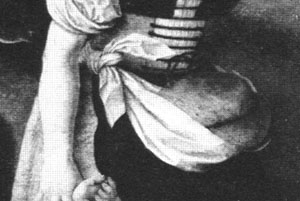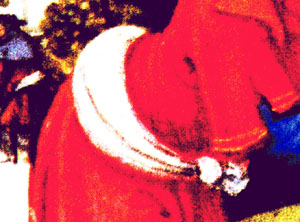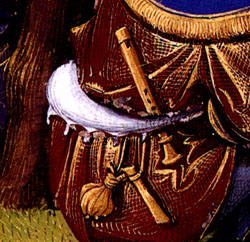

Main Menu - Misc. - Clothing/Textiles - Medieval Wales - Names - Other Medieval - Publications - Harpy Publications
Return to main page
The following scenes are particularly useful for showing details of the construction of the pouches involved. Unfortunately, they don't necessarily show typical constructions for the Shepherds Purse. The basic "crescent" and "flapped crescent" shapes of purse rarely show significant details of the construction. In all cases, discussions of the construction should be understood to be prefixed with "if we can trust the depiction to accurately reflect the structure of an actual artifact".
The two net-only pouches from the Tres Belles Heures de Jean de Berry, if interpreted as accurate renditions, indicate a rectangular piece of square netting (i.e., with the lines of the mesh paralleling the outer edges of the piece as a whole), where two opposite ends are gathered up into a single point, and the pouch hangs from those two points. It is unclear whether the remaining two sides constitute a slit-opening for access along the top edge, or whether we are actually dealing with a tubular piece of netting (i.e., those two sides are actually attached to each other), and access would be accomplished by a drawstring closing one of the ends. In the figure on the right, the darker patterns behind the net may indicate an object contained within the pouch, or may be part of the shadows of the folds of cloth in the tunic skirts (which can be seen below the pouch). From the way the netting hangs, the pouch itself does not encircle the waist. It may be attached to two points on the belt (the drape of the tunics clearly indicate belts, although they are not actually visible), but an alternate explanation could involve a shoulder strap. Note the two white lines over the shoulders on the left-hand figure. I would interpret them as belonging to the hat (or whatever the round object is just behind the head), but the right one is in the correct position to be a shoulder strap for the net. Similarly, in the right-hand figure, the left end of the net appears as if it may rise higher than the tunic fold above the belt, which would imply a shoulder strap rather than belt attachment. But with these caveats, my overall impression is that there is a stronger argument for belt attachment than for a shoulder strap. Compare with the netted bag in the Paris Psalter. There are several lines that might be shoulder straps (either on the same or opposite shoulder as the bag) and the hang of the net would be consistent with either belt or shoulder position.


Several works show clear details involving a simple cloth, knotted around the waist (or attached to the belt in some way) and used as a carrying device. The clearest -- although it doesn't strictly fall in our shepherd category -- is in the painting of Abraham and Hagar, where two loaves of bread can be seen semi-contained in the cloth, and the knotted ends of the cloth are visible at the side. From a mechanical viewpoint, this would appear to work best if the edge of the cloth going around the front of the bread is on a straight grain. The knot appears to be of the "granny" variety.

Although the picture is somewhat grainy, the rather fastidiously-dressed shepherd in Bibl. Nat. Paris MS 42 wears, at the very least, a sash-belt, with some type of bulky knot in the fabric at the front. The taper of the fabric, from a slight bulge at the back to a relatively narrow gather feeding into the knot, suggests that some type of contents are enclosed in the fabric, presumably by virtue of rolling them up in a rectangular cloth before tying the cloth around the waist. This arrangement is essentially identical to items that have no "bulge" and that appear to be serving only as belts. Conversely, if the current item were viewed at an angle such that the knot were invisible, it would appear very similar to a crescent-shaped Shepherds Purse (or, taking into account the line following the outer edge, to a simple flapped crescent pouch).


Although the detail level is low (being a wood-cut), the Hardouyn Book of Hours gives a useful clue to the structure of the crescent-shaped pouch (at least in some versions), appearing to show a shepherd reaching into a Shepherds Purse at his side to remove something while the article is still being worn. (Unfortunately none of the figures in the scene shows an entirely clear and unmistakable Shepherds Purse, although one other has strong indications of one.) This method of access would be consistent with the depictions of pouches with a flap that extends either part way or most of the way down the outer side. It would contrast with those pouches where access appears to be via a gathered end (which would presumably need to be removed entirely to be accessed).

The simple lines of the pouches in the Simon Marmion Hours, along with the position of the knotted tie, indicate a fairly clear construction type. The tie presumably originates (underneath) from the upper edge of the outer side of the pouch. The pouch would then appear to be constructed from two major pieces: a roughly circular piece which forms the back of the pouch and the flap, and a roughly half-circular piece which forms the front of the pouch. At the "corners", when the circle is folded in half, straps are attached to go around the waist. This would be a major leap from a pouch that derived from a single piece of manipulated cloth.

The pouch seen in the Da Costa Hours more clearly shows some gathering from the pouch into the straps at the side. An effect like this might be more consistent with a pouch section that begins more or less as a rolled tube (with the outside edge forming the flap) that is gathered at both ends into a strap. The markings on the flap suggest that it may be buttoned to the upper edge of the underlying fabric. It is possible that the smooth, more cut-and-shaped look is an artistic simplification of a structure more like this -- but it's equally possible that the cut-and-shaped look of the crescent -shaped purse evolved from this style, but does, in fact, represent the actual construction.

On the other side of the argument, the rare examples where the lower edge of the pouch shows some sort of fringe or indented edge argue fairly strongly for a seam of some type in that position. One pouch in the Repas Champetre indicates this fairly clearly. In some cases, the fringed or indented edge could conceivably be the edge of a flap that covers the entire pouch, but here the edge of a flap is visible slightly above the indented fringe.

The representations of a flapped-crescent shape seen in the tapestries are sometimes more consistent with an origin in a single cloth, rolled around the contents, and then gathered up (into a strap) at the ends. The pouches seen in Rustic Sports (below) are more reminiscent of the "Pursuit of St. Barbara" shape (but with the corners continuing into a strap), rather than necessarily being constructed from multiple pieces of cloth. Overall, there seems to be convincing evidence both for single-piece and sewn-shapes versions of the crescent-shaped pouch. (The section on experimental reconstruction will discuss possible versions and evolutionary paths.)
Of further interest is the position and function of the carrying-rings on this and the following example from La Main Chaude. In both cases, these rings are attached to the flap -- near, but not at, the upper edge of the pouch. On a mechanical basis, the weight of the attached objects, while not extreme, is significant, and could have served to keep the flap closed. But that weight would also be expected to rotate the pouch outwards, if there is no internal structure other than that of wrapped cloth. This is especially the case if (as I hypothesize) the fabric lies with the bias following the waistline. Pouches with these types of attachments would be most stable if the straps that encircle the waist also continue through the pouch in some fashion and provide a non-elastic, close-fitting base from which the pouch and the attached implements hang. One possible method would be to have a continuous "belt" structure attached to the back portion of the pouch (just where the flap folds down), which would certainly bear the weight of the tools sufficiently. Another possiblity that will be discussed further in the reconstruction section would be a continuous "belt" attached along the upper edge of the front part of the pouch (hidden under the flap) -- an edge that, by some reconstruction theories, might need extra stabilizing to create a more functional pouch.
In the vast majority of Shepherds Purse portrayals, the pouch section of the object is positioned towards the viewer, with the fastening method -- presumably -- hidden from view behind the wearer. While it can't automatically be extrapolated to all cases, the Bedford Hours Annunciation sheds light on this question, clearly showing a loose strap end (and, with only a little imagination, a buckle), just at one end of the pouch section of the object. This is particularly interesting since the pouch is of the netted style. If the network represents a closed tube accessed from one end, is that access at the visible end (terminating in a short strap)? Or at the hidden end (terminating in a long strap ending in a buckle)? Unclear. Is the strap simply run through the interior of the netted tube or in some way fastened to it? The near end tapers in a ways that suggests some sort of fastening.

I have become increasingly of the opinion that the Shepherds Purses (worn both by shepherds and swineherds) in the Hours of Henry VIII have lost touch with their "real-object" origins and have become stylized artistic motifs. The plain pouch (on the left) is much smaller in volume than the more realistic-looking ones, and the netted motif (on the right) depicts a rather unfunctionally-large mesh size. Given the otherwise excellent level of detail on this work, this is rather unfortunate.


The Hours of Mary of England help answer one nagging question: to what extent do shoulder versus waist positions represent entirely different styles of pouch? I have noted a number of examples that show many of the same stylistic features of the Shepherds Purse except that they are worn from a shoulder strap. In this scene, two shepherds in the same group wear objects that are entirely identical except that one is slung over the shoulder and one around the waist. The waist position -- which is an essential part of my definition of the Shepherds Purse "gestalt" -- is much commoner, and is the only one associated with attached objects. This suggests that there is some mechanical or behavioral benefit to the waist position in this occupational context. But the shift of Shepherds Purse-style carriers to being worn over the shoulder both gives evidence for the construction (e.g., the "containment" function doesn't depend on pressure against the waist) and lends some support to the "actual artifact" side of the debate, where the obejct is seen as being manipulated in various ways.


Several pouches show details of construction methods that don't appear to be typical for the common Shepherds Purse style, even when they share the overall gestalt. The Da Costa example discussed above is somewhat marginal to the typical depictions (although it may be unusual only in its relatively clear details). Some objects that fall outside the Shepherds Purse group are also of considerably interest for the clarity of their construction (such as the "gathered sausage" shoulder bag in the del Barco annunciation), but I will not cover them here.
The bag in the Stockholm-Kessel Book of Hours is certainly worth investigating, although it may not shed light on the structure of more "mainstream" pouches. The pouch forms a rough half-circle, where the left-hand end is pursed up with a drawstring and the right-hand end narrows smoothly into a point. The upper edge (along the waist) shows a row of four or more buttons but there are no signs of a flap, suggesting that the upper edge is simply two open edges pressed together in parallel.
If we visualize the drawstring being loosened and the gathered end being stretched out flat, it appears that we will end up with some vaguely triangular shape, with two sides open (the upper buttoned edge and the previously-gathered edge) and the third most likely on a fold. Visualize, then, a rough square of fabric, hung like an apron by a strap around the waist, with buttons on that waistband. Fold one bottom corner up to its opposite and button the top edges together. Then run a drawstring through the remaining open edge. At the time I first wrote the preceeding description, I hadn't tried an actual reconstruction yet. The mock-up matches this interpretation precisely and works surprisingly well (see the reconstructions).

Previous --------------------------------------------- Main --------------------------------------------- Next
This site belongs to Heather Rose Jones. Contact me regarding anything beyond personal, individual use of this material.
Unless otherwise noted, all contents are copyright by Heather Rose Jones, all rights reserved.